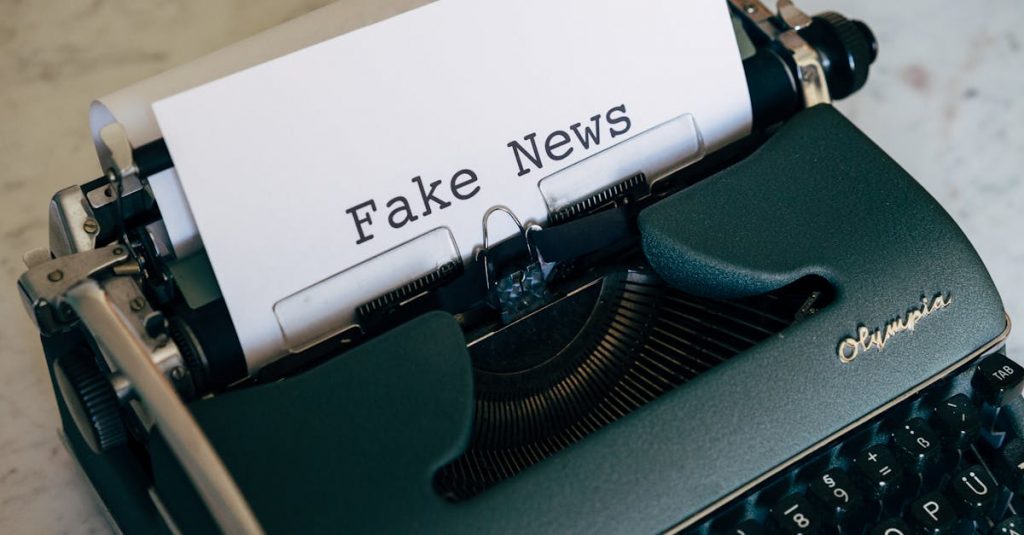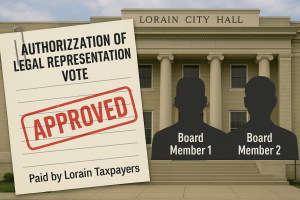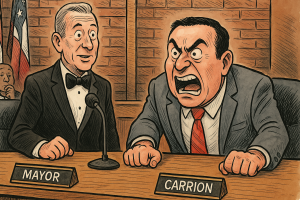The Chronicle-Telegram’s Slanted Saga: A Media Bias Meta-Review

“There Were No Charges. There Was No Case. Just a Smear Disguised as Due Process.”
May 03, 2025

I. Introduction: A Tale of Three Headlines
In covering a now-dismissed Temporary Protection Order request against me, the Chronicle-Telegram published three separate articles—each more slanted than the last. Rather than inform the public with balance or rigor, the newspaper engaged in a form of narrative laundering, framing unsubstantiated allegations as near-fact while burying or ignoring evidence that contradicted them. The timeline of this media campaign spans three pieces: the April 15 article titled Amherst Township woman granted protection order against Lorain City Council candidate Aaron Knapp (Article), the April 30 article titled Hearing pushed to Friday on protection order against Lorain Council candidate (Article II), and the May 3 piece headlined Tia Hilton nixes request for protection order against Lorain Council candidate Aaron Knapp (Article III).
Thanks for reading Aaron’s Substack! Subscribe for free to receive new posts and support my work.
The result is a lopsided, misleading portrayal that demands correction—and exposure.
At no point in any of these reports did the Chronicle give meaningful space to my legal defenses, my documentation, or the actual evidentiary collapse that occurred in open court. They clung to headlines long after the facts changed. They repeated unproven allegations, never questioned contradictions, and gave the microphone almost entirely to the petitioner and her legal counsel.
The purpose of this meta-review is not just to set the record straight. It is to reveal how easily a narrative can be engineered—and how few questions are asked when the target is politically inconvenient.
II. Headline Misdirection: Misleading from the Start
The digital version of The Chronicle-Telegram’s article on the dismissal of the TPO initially bore the headline “Tia Hilton nixes request for protection order against Lorain Council candidate.” This phrasing—“nixes”—suggested a voluntary withdrawal and minimized the legal context in which it occurred. It positioned the petitioner as the one in control of the outcome rather than someone whose case lacked evidentiary support. That digital framing stood in contrast to the courtroom facts and created a misleading impression from the outset.
Later, the digital article was updated to say “Tia Hilton protection order dismissed,” and this revised headline made its way into the Saturday, May 3, 2025 print edition. The placement was prominent, across the top of the front page, but the correction came only after the damage of the original framing had taken root. Crucially, no formal editor’s note or visible update alert was added to inform readers that the framing had been changed—leaving early readers with an inaccurate takeaway. A screenshot of the original headline “nixes request” has been preserved and can be made available via timestamped web cache or metadata upon request.
Even the updated version of the headline—while more accurate—still failed to inform the reader that the petitioner’s own witness did not appear and that the court dismissed the case after rejecting attorney Gerald Phillips’s last-minute request for a continuance. This omission is significant because it speaks to a pattern of decontextualized reporting that amplifies accusations but withholds equivalent energy when the case falls apart.
Further, this was not an isolated headline problem. The Chronicle’s April 20 article was titled “Amherst Township woman granted protection order against Lorain council candidate,” a framing that failed to note the order was temporary and ex parte—granted without a full hearing or response. On April 29, a follow-up titled “Hearing pushed to Friday” failed to mention that the delay was granted due to the respondent’s documented medical appointment, creating the false impression that he was stalling.
All of this would have remained in the realm of editorial oversight were it not for what followed in court: Phillips filed his notice of appearance at 1:22 p.m., just eight minutes before the scheduled hearing—despite having already subpoenaed multiple witnesses days prior. This demonstrates not only that Phillips was actively working on Hilton’s behalf before notifying the court and the respondent, but also that the respondent, Aaron Knapp, received notice of representation only in the courtroom itself, minutes before proceedings began.
This sequence of headlines and omissions paints a broader picture of narrative control. When Hilton filed her petition, it dominated news coverage. When her sole witness failed to appear and her attorney’s arguments unraveled, the coverage was muted, passive, and sanitized. This wasn’t just a lapse in journalism—it was a misrepresentation by omission.
[Link: Article ]
III. Media Double Standards on Legal Process
The Chronicle-Telegram’s handling of this matter reveals not just a bias in framing, but a double standard in how legal process is interpreted—depending on who is being scrutinized. The coverage offered no meaningful challenge to the petitioner’s side, treated courtroom innuendo as credible, and ignored judicial norms that would have cast the case in a dramatically different light.
Take, for example, the central issue of due process. The paper quoted the petitioner’s fear and accusations with full gravity but never addressed the procedural imbalance created by the ex parte nature of the initial TPO. An ex parte order means no hearing was held, no evidence was tested, and the accused (in this case, me) had no opportunity to respond. Yet the paper framed it as though guilt had already been substantiated. No disclaimer about the ex parte standard was included in the first article.
Then there’s the selective silence on courtroom dynamics. When the petitioner’s only witness, Jon Morrow, failed to appear—resulting in the voluntary dismissal of the case—the Chronicle didn’t even mention his absence until deep into the third article. They certainly didn’t question what it meant: that the sole piece of evidence, a hearsay claim without documentation, fell apart when subjected to even minimal scrutiny.
Contrast that with how the paper treated my decision to appear without counsel. It was mentioned, subtly, in a way that seemed to highlight imbalance—but not to question why Phillips, the petitioner’s attorney, filed a notice of appearance eight minutes before the hearing while having already submitted subpoenas in prior days. There’s no investigation into whether this blindsided tactic was ethical or fair. The Chronicle gives no space to this obvious ambush. No probing questions. No exploration of the timeline.
And where were the questions about Phillips’s conduct in court? He invoked “pending criminal charges” to justify a delay—charges which, to date, do not exist.
No public record shows that any such charges were filed or are being considered. The paper printed this claim without pushback, despite the clear danger of using the specter of law enforcement to sway a civil matter.
Meanwhile, I submitted extensive documentation to the court—evidence from police reports, incident logs, and contradictory statements made by the witness in question. The Chronicle had access to this information. They were present. They heard it argued in court. Yet their stories contain none of it.
Instead, the narrative constructed is a story of tension, accusation, and mystery. “Knapp claims…” “Hilton alleges…” “Phillips says…”—a chain of dueling statements with no fact-checking, no verification, and no editorial curiosity.
This is not journalism. It’s stenography. Worse, it’s editorial abdication. The Chronicle allowed courtroom innuendo to dictate the public understanding of a legal proceeding that ultimately collapsed. They helped weaponize process, and then quietly stepped away once it failed.
What should have been asked is simple: If a witness fails to appear, if a petitioner retreats under the pressure of real evidence standards, and if the judge lifts the order—what does that say about the initial claim? What does it say about how easily our courts can be used to tarnish reputations without due process?
The Chronicle refused to ask. But readers should.
IV. The Phantom Charges: A Slanderous Legal Gambit
During the May 2, 2025 hearing, attorney Gerald Phillips stood before the court and, in an effort to delay proceedings, declared that “pending existing criminal investigations that may be filed very shortly” should justify a continuation. He did not name a defendant, cite a case number, or produce any documentation. This was not evidence—it was innuendo, raised in front of the magistrate with no opportunity for cross-examination.
The timing and structure of the statement strongly suggest it was meant to prejudice the court while avoiding responsibility for a formal allegation. The Sheriff’s report, released prior to the hearing, noted that the investigation was closed with no charges filed. The Oberlin Prosecutor similarly declined any filings. Yet Phillips, in open court, insinuated that such filings were imminent. This maneuver mirrors the very definition of reckless disregard for truth and, in the court of public opinion, closely resembles slander.
The tactic was not merely procedural—it was rhetorical. It was designed to tilt the courtroom air toward guilt by implication. The Chronicle repeated it without question.
Phillips’s legal gambit backfired when the magistrate refused a delay and pressed forward. The witness—Morrow—failed to appear. The case collapsed on its own evidentiary hollowness. Phillips’s comment hangs in the record like a smear delivered under color of authority.
The hearing transcript confirms Phillips said this moments before requesting dismissal, using the phantom charges to suggest the court should stay the matter indefinitely. It didn’t work. But the insinuation traveled farther than the truth.
V. A Missing Witness, a Missing Story
In a courtroom, the absence of a witness often speaks louder than their testimony ever could. That principle played out unmistakably in this case when Jon Morrow, the petitioner’s only named witness, failed to appear. The entire claim rested on Morrow’s alleged account of a threatening statement—one which even in its most generous reading amounted to hearsay with no supporting evidence. Without him present to testify, the case collapsed. Yet, somehow, the Chronicle-Telegram missed the real story.
Instead of interrogating why the witness wasn’t there, or what that meant for the integrity of the underlying claim, the Chronicle simply stated that the matter was dismissed. The vacuum of explanation left readers assuming it was some voluntary, strategic withdrawal—as though the petitioner had made her point and chosen not to press further. This omission is not just misleading; it is a journalistic failure.
The reality, as the court record shows, is that Magistrate Laura Dezort insisted the hearing go forward. Phillips asked for more time, citing vague allusions to investigations. Dezort refused. Faced with the requirement to proceed—without a witness, and without admissible evidence—Phillips had no choice but to withdraw the request. The protection order was lifted.
That’s the story. Not just that the petitioner walked away, but that her claim could not survive the most basic evidentiary scrutiny. It unraveled under the weight of its own speculation. The Chronicle’s decision not to mention Morrow’s absence until deep into the third article—and without examining its implications—shows either astonishing incompetence or a deliberate editorial choice to protect the narrative.
Jon Morrow’s name had been central in prior police reports and in statements made to the media. His supposed testimony had been the linchpin of the entire case. And when the day came to offer that testimony, he didn’t show. If this were a criminal prosecution, the charges would have been dismissed for lack of evidence. In the civil context, that’s exactly what happened. But the Chronicle sanitized that failure.
More troubling is that Morrow’s own credibility had already been in question. Prior to the hearing, he made conflicting public and private statements about me—praising my work one week and accusing me the next. He admitted that his account was based on something allegedly overheard in a Facebook audio conversation weeks earlier, for which no recording exists. Law enforcement closed their investigation with no charges filed. These contradictions were documented and submitted in court. The Chronicle saw the paperwork. They ignored it.
Why would a serious newspaper sidestep the most important collapse in the case? Why wouldn’t they report that the petitioner’s only evidence was hearsay, unsupported, and ultimately unpresented? The answer is simple: the truth doesn’t sell as well as the smear. The insinuation of threat carries weight. The unraveling of that claim does not.
Even more damning is that Morrow had ample notice of the hearing. If he believed in the validity of his account, nothing stopped him from appearing. He chose not to. And his absence tells us everything we need to know about the credibility of the original accusation.
The Chronicle had an opportunity—several, in fact—to inform its readers that the central witness failed to support the central claim. They declined. In doing so, they protected a collapsing narrative from public scrutiny and allowed the stigma to linger unjustly.
This isn’t just about one witness. It’s about whether we expect reporters to tell the full story, or whether they are content to leave out the inconvenient truth. In this case, the truth was Morrow’s silence. And it should have spoken volumes.
VI. The Journalist Who Became a Witness
Behind the curtain of the hearsay that fueled this entire debacle stands a figure who should have raised alarm bells for any newsroom committed to integrity: Heather Chapin of the Morning Journal. Rather than investigate or verify allegations, Chapin acted as a conduit—if not a catalyst—for the claim that I made a death threat. But instead of journalism, what she delivered was gossip, funneled to the Lorain County Sheriff’s Office without corroboration or context.
According to the sheriff’s report filed in April 2025, Chapin relayed what she claimed was secondhand information: that a man named Jon Morrow overheard me say, in a Facebook audio call, that I “would like to see [the petitioner] dead.” Morrow never recorded the call. The conversation supposedly took place weeks prior. No other individual corroborated the quote. And I was never interviewed. Yet Chapin, a working journalist, did not report this claim in print or vet it through editorial channels—instead, she delivered it informally to law enforcement.
That’s not journalism. That’s becoming part of the story. And once the story collapsed—once Morrow refused to testify and no evidence emerged—Chapin never retracted, never clarified, and never reported on the outcome she helped instigate. Her name does not appear in Morning Journal coverage of the court hearing, even though she set the entire chain of events into motion. Her silence speaks volumes.
It is difficult to overstate the ethical breach here. Reporters have a sacred duty to maintain distance from the facts they cover. They are to observe, question, and verify—not insert themselves as participants. By relaying an unconfirmed, politically sensitive statement to law enforcement, Chapin crossed that line. Worse, she did so without acknowledging that she had previously targeted both myself and my associates in coverage tied to local politics.
This wasn’t a case of civic concern. It was political interference dressed up as concern. And the public deserves to know who set that in motion. If a reporter’s tip becomes the only basis for a criminal allegation, that reporter has ceased to function as press and has instead become a witness. In any credible newsroom, such a conflict would warrant investigation and likely recusal. Yet here, the Morning Journal took no steps to disclose Chapin’s role.
More troubling still, the Chronicle-Telegram—which surely knows of Chapin’s involvement—declined to report it in any of their three articles. They never mentioned that another journalist was the origin point for the claim. They never explained how hearsay from a Facebook call morphed into a court proceeding. The omission wasn’t just oversight; it was collaboration by silence.
To date, I have received no clarification, no apology, and no offer to correct the record from Chapin, the Morning Journal, or the Chronicle. They built the foundation of this scandal on hearsay passed through a journalist acting outside her role. And when that foundation collapsed, they simply stopped asking questions.
In an era when trust in journalism is rapidly eroding, moments like this matter. If a journalist becomes a witness, they owe the public an explanation. If a media outlet reports an allegation, they owe their readers a follow-up when that allegation is dismissed. And if they fail on both counts, it’s not just bias—it’s betrayal.
VII. What They Knew, and When They Knew It
Throughout this media circus, one thing has become painfully clear: the Chronicle-Telegram and the Morning Journal were not operating in a vacuum of ignorance. They knew the gaps in the story. They knew the timeline. They knew who had spoken to whom—and when. And still, they chose to run with a version of events that propped up a narrative while obscuring the facts. The chronology of their reporting and the court records reveals a pattern of omission that amounts to journalistic malpractice.
Gerald Phillips, the petitioner’s attorney, filed his notice of appearance just eight minutes before the scheduled hearing. And yet subpoenas had already been sent out in his name before that filing occurred. The record is indisputable. The petitioner’s team was already preparing legal maneuvers while concealing from the respondent that she had retained counsel. I was informed in the courtroom itself—mere minutes before the hearing—that Phillips would be representing her. The Chronicle knew this. They had access to the docket. They knew the timelines. And they left it out.
They also failed to mention that the hearing had previously been rescheduled at my request due to a medical appointment—painting instead a false impression that the petitioner’s side had been accommodating while I was delaying the process. In doing so, they flipped the chronology to suit the story. It’s a subtle manipulation, but it matters. It casts doubt. It assigns blame. It creates the illusion that my defense was evasive rather than procedural.
Even when Phillips made his outlandish claim about “possible pending charges,” there was no pushback from reporters. No request for clarification. No inquiry to the prosecutor’s office. The Chronicle didn’t ask whether any investigation had occurred, whether probable cause existed, or whether anyone had even spoken to me. They didn’t ask because they didn’t want the answer. The innuendo served their purposes.
And let’s not forget the framing of the final article. The headline claims Hilton “nixed” her request—as if the case had been voluntarily withdrawn for personal or strategic reasons. That framing ignores what actually happened: the petitioner’s only witness failed to appear, and her lawyer, facing a magistrate who refused further delay, moved to dismiss. That is not a tactical withdrawal. That is a failed prosecution. And the media chose not to say so.
What’s more, the Chronicle included quotes from Phillips in that final piece but excluded any detailed explanation of my legal arguments or the extensive documentation I presented to the court. They never reported that I had submitted nearly 20 exhibits, ranging from harassment screenshots to police statements and documented contradictions from the petitioner’s witness. They reduced the entire case to political theater—and painted me as the actor.
This wasn’t a failure of access. All filings were public. All evidence was available. The court hearing was on the record. Yet none of it made it into print. The Chronicle had the opportunity to correct course. They had a second chance, then a third. And they chose, each time, to double down on the original narrative rather than confront their error.
Even the claim that I “made headlines recently” because of the April 5 incident at MAHD House is a distortion. That case remains unresolved. I was the victim in that event. I filed the police report. And yet, the Chronicle framed it as if I had once again created controversy. Their reporting didn’t just omit my side; it implied guilt by association, connecting the dots they wanted readers to see.
This raises the most important question of all: what did the Chronicle know, and when did they know it? The answer, based on public records and publication dates, is that they knew enough to tell a different story—and they chose not to. This wasn’t lazy journalism. It was deliberate bias masked as reporting.
The damage of such journalism isn’t just to me. It’s to the public. When newsrooms knowingly shape stories to fit their preferred narrative, they erode public trust in the very institutions they’re meant to serve. And in this case, they didn’t just protect power—they became part of it.
VIII. A Pattern of Political Targeting Disguised as Coverage
Zooming out from this specific incident, a troubling pattern emerges—one in which certain public figures in Lorain County are routinely cast in a favorable light while others, especially critics of local leadership, are caricatured or framed as agitators. The Chronicle-Telegram’s treatment of me fits squarely into this larger schema. My identity as a conservative candidate, a disabled veteran, and a frequent critic of city leadership made me a convenient target for character assassination under the guise of journalism.
This isn’t conjecture. Over the past two years, the Chronicle has disproportionately spotlighted negative or sensationalized claims—such as its April 2024 front-page coverage headlined ‘Amherst Township woman granted protection order against Lorain City Council candidate Aaron Knapp’ despite the order being ex parte and temporary, and its June 2023 article on my courthouse encounter which emphasized ‘escalation’ while omitting my own complaint of retaliation. In contrast, the paper gave minimal or no coverage to whistleblower allegations against Lorain Police Chief James McCann and failed to follow up on multiple citizen reports of harassment or misconduct by city insiders about individuals affiliated with reform efforts, especially those who challenge the political status quo in Lorain. Those aligned with city hall or entrenched Democratic power brokers tend to receive sympathetic, even uncritical, portrayals. When misconduct emerges among those figures, the paper often softens the language—“miscommunication,” “ongoing review,” “policy disagreement.” When it involves critics? The tone shifts to scandal, threat, and insinuation.
In my case, every article about the protection order was tinged with that narrative framing. I wasn’t described as a council candidate or whistleblower. I was labeled by implication: man under a protection order, man connected to bar fights, man linked to controversy. At no point did the Chronicle explain that I had filed the police report regarding the April 5 assault at MAHD House, as documented in Lorain County Sheriff’s Office Report #2025-10686, filed on April 15, 2025, in which I, as the victim, provided a full account and requested prosecution regarding the April 5 assault, or that no charges were filed against me in that matter either. The suggestion was always that I was on the defensive—even when the facts showed otherwise.
Nowhere did the Chronicle provide context about my community work, my advocacy for transparency, or my whistleblower history. And certainly not my documented efforts to hold city officials accountable. These details weren’t buried; they were omitted. Their absence helped build a narrative of me as a volatile figure, not a concerned citizen under targeted political harassment.
More broadly, the Chronicle’s reporting has shown a tendency to downplay serious allegations when they involve members of Lorain’s political establishment. When local officials were credibly accused of retaliating against whistleblowers—such as in the case of Lorain Police Chief James McCann, who faced internal investigations and EEOC complaints over alleged retaliation against Lt. Corey Middlebrooks and others—, leaking sealed records, or intimidating community activists, those stories barely registered in the editorial calendar. Some never ran at all. But the minute a story breaks that can cast a known critic in a bad light—especially if it includes words like “protection order” or “death threat”—the full machinery of coverage is activated.
This isn’t journalism. It’s narrative engineering. And it’s especially dangerous in a small community like Lorain, where trust in institutions is already tenuous. When the press picks sides—when it rewards those in power and undermines those who dissent—it stops serving the public interest and starts becoming part of the machinery it’s supposed to watchdog.
And while most readers wouldn’t see the patterns unless they were looking closely, for those of us on the receiving end, it becomes obvious. We see how headlines are chosen. How stories are sourced. How opposing voices are given less ink—or none at all. We watch as our words are cut, our roles are misrepresented, and our victories are framed as retreats.
In my case, the full picture is not only missing—it was deliberately kept from readers. And that is not just a failure of journalism. It is a weaponization of it. It is the use of a public trust—the press—as a tool to settle political scores and silence dissent.
IX. Collusion or Coincidence? The Lines Between Press and Petitioner Blur
At several key points in this ordeal, the actions of the Chronicle-Telegram and those of petitioner Tia Hilton seemed to move in parallel—not coincidentally, but with uncanny synchronicity. Consider this: days before the full hearing, while legal motions were still pending, the Chronicle ran an article strongly implying guilt, painting me as the aggressor. That article, quoting unnamed “concerned parties,” echoed language nearly identical to what would later appear in Hilton’s court filings. That’s not journalism. That’s narrative laundering.
This overlap raises serious questions. Who was feeding the Chronicle? How did they know to quote fears of “community safety” or cite supposed “ongoing investigations” when none had been confirmed by authorities? Why did they repeat, almost verbatim, the same phrases Hilton and her legal counsel would later use in open court? We must ask whether Chronicle reporters had pre-publication contact with Hilton or her allies to shape coverage that would benefit her legal strategy. If so, that crosses the line from reporting into active collaboration.
The most glaring example is the role of Heather Chapin at the Morning Journal, whose secondhand hearsay launched this entire saga. She was not merely reporting news—she was involved in making it. Chapin admitted in police interviews that her information came from unnamed third parties. Yet that baseless hearsay ended up in the sheriff’s incident log and eventually in Hilton’s TPO request. The press pipeline didn’t follow the facts—it built the case.
Even after the case was dismissed and the magistrate lifted the TPO, Chronicle reporting continued as if the claims were still unresolved. The story emphasized that Hilton “retained the right to refile” rather than acknowledging the complete failure of her legal argument. No mention was made of the absent witness. No retraction was issued for prior stories. They chose to preserve the cloud over my name rather than correct the record.
Furthermore, when Gerald Phillips—Hilton’s attorney—insinuated possible criminal charges on the record, no reporter asked for evidence. No follow-up call was made to the prosecutor’s office. Instead, they treated the mere suggestion of criminality as newsworthy fact. The press didn’t just report the allegation; they reinforced it by publishing it without challenge or balance. They created a breadcrumb trail that falsely legitimized an unsubstantiated smear.
This synergy between courtroom tactics and newsroom spin isn’t accidental. It’s part of a larger pattern in Lorain County journalism where certain political alliances receive protective coverage while dissidents are demonized. Reporters act less like neutral observers and more like partisan amplifiers. When journalism becomes an extension of political warfare, truth becomes collateral damage.
The deeper concern is institutional. The Chronicle-Telegram still positions itself as Lorain’s “paper of record.” It claims to serve the public interest. But in this case, it served as a vehicle for a personal and political vendetta. It advanced the narrative of a single litigant while ignoring the mountain of counter-evidence and dismissing the rights of the accused.
What began as a petition for a temporary order devolved into a full-scale media trial. The press provided the venue, Hilton supplied the claims, and due process was left in the hallway. My political platform, my community service, my legal rebuttals—none of it mattered. The court ruled in my favor, but the Chronicle’s headlines still read like prosecution briefs.
In the end, the question isn’t just about media bias. It’s about complicity. The Chronicle-Telegram didn’t merely fail to report fairly—they helped manufacture a public narrative with legal consequences. They amplified unfounded allegations, concealed exculpatory facts, and worked in sync with those seeking to silence dissent. This wasn’t just bad journalism. It was coordinated character assassination masquerading as news.
X. The Final Smear: When Journalism Becomes a Weapon
If one moment crystalizes the collapse of objectivity in the Chronicle-Telegram’s coverage, it is reporter Dave O’Brien’s blunt April 21 email to me, asking whether I had told Jon Paul Morrow, “I’d like to see that bitch dead.” No context. No courtesy. Just a crude, accusatory quote lobbed by email, drawn from a claim with no evidentiary support and flatly denied by me multiple times. That single question reveals how the Chronicle blurred the line between probing journalism and prosecutorial ambush.
The question itself originated with Morrow’s claim, made weeks after an alleged March 20 Facebook call—one that was never recorded, never substantiated, and not corroborated by any witness. In fact, my call logs disproved it. The police report shows Morrow’s statement hinged on secondhand memory and emotional speculation. The Sheriff’s Department and Oberlin Prosecutor declined to press charges. Still, O’Brien chose to lead with Morrow’s baseless quote.
What journalist presents a defamatory allegation as a yes-or-no question without confirming facts first? Worse still, O’Brien ignored the chronology: the message allegedly occurred before I was ever accused of anything, but Morrow’s story only surfaced after the MAHD House incident. It was a retroactive justification, and the Chronicle eagerly printed it.
When I replied to O’Brien’s email, I denied the quote unequivocally. I attached transcripts, phone logs, and proof that Morrow’s timeline didn’t add up. I noted that the authorities had declined to pursue charges. But those facts never made the headline. Instead, the Chronicle ran coverage suggesting Hilton’s case had merit and Morrow’s hearsay was credible.
By May 2, the case had been dismissed. Hilton’s attorney withdrew the claim. The subpoenaed witnesses never testified. The magistrate declined further delays. And I stood ready with my exhibits, evidence, and cross-examination. Even then, I had to ask O’Brien and Carissa Woytach whether they intended to publish the outcome. When they finally did, it lacked the prominence or urgency of the initial “protection granted” headline.
What this reveals is not just bias—it is complicity in manufacturing a public narrative. At no point did the Chronicle acknowledge how weak the claims were. At no point did they revisit Morrow’s absence or Hilton’s decision to drop the case rather than testify under oath. The public was left with a half-finished story and an unfair impression.
This episode should disturb anyone who believes in fairness, accuracy, and the integrity of journalism. When reporters act as proxies for political or legal agendas—whether wittingly or not—they betray their obligation to truth. When they platform accusations without evidence but bury exonerations, they weaponize the press.
The smear didn’t come from a courtroom. It came from a newsroom. And the people of Lorain deserve better.
XI. Selective Silence: The Stories That Never Made Print
If journalistic integrity is measured by what a newsroom chooses to investigate—not just what it reports—then the Chronicle-Telegram has failed its own standard. In the year leading up to Hilton’s protection order filing, multiple public controversies unfolded across Lorain County involving the same individuals and power networks. These included whistleblower complaints against law enforcement leadership, misuse of public resources, and retaliatory investigations against critics. Yet the Chronicle never ran in-depth stories about those cases. It didn’t probe systemic patterns. It didn’t follow up.
Why? Because those stories didn’t fit the paper’s preferred narrative. For instance, the internal affairs investigation into Lorain Police Chief James McCann—which documented extensive allegations of discrimination and retaliation—received no prominent coverage. Despite including over 380 pages of interviews, policy violations, and legal findings, the Chronicle passed. A comprehensive, documented civil rights controversy was effectively ignored.
Contrast that with the wall-to-wall coverage of Hilton’s protection order. Within days of her petition, the Chronicle had already published two front-page articles, complete with mugshot-style headlines and uncritical recitations of Hilton’s claims. That disparity reveals a profound editorial imbalance. Real, substantiated misconduct didn’t get ink. But unverified allegations from a political activist did.
Even more disturbing is the failure to update the public once the truth emerged. After Hilton dismissed her petition and failed to produce a single witness, the Chronicle’s follow-up was an afterthought. No retraction. No investigation into how false claims made it into sworn petitions. No review of the damage done. Silence.
The Chronicle’s reporters knew about the inconsistencies. They had copies of the Sheriff’s report showing Morrow’s hearsay had no evidentiary basis. They had my public records filings. They had transcripts proving Hilton’s story had changed repeatedly. But none of that made print.
This selective silence isn’t just laziness. It’s strategy. It allows the paper to shape public perception while avoiding accountability. By omitting exonerating facts, they insulate their initial framing from scrutiny. It’s a clever tactic—report first, retract never.
Consider one telling example: Hilton’s menacing complaint against another woman in 2023, which also failed in court. That episode was a matter of public record. It demonstrated a pattern of dubious allegations. But the Chronicle never mentioned it. To do so would undercut their narrative.
Meanwhile, my own record—of military service, social work, and public advocacy—was reduced to a footnote, if acknowledged at all. Instead of telling the full story, the Chronicle cherry-picked the facts that fit their angle.
When reporters know the truth but refuse to print it, they become participants in the very injustices they claim to expose. Journalism demands more than headlines. It demands honesty. And in Lorain, that demand is not being met.
XII. Legal and Ethical Notice: When Journalism Crosses the Line
This exposé was written to shed light not only on the conduct of one petitioner and her legal team, but also on the broader pattern of negligence and malice in Lorain County’s local media apparatus. The facts cited herein are drawn from sworn court filings, public records, law enforcement reports, and documented correspondence between the undersigned and various journalists, including David O’Brien and Carissa Woytach of The Chronicle-Telegram. The emails reproduced in this article were either sent directly to the undersigned or entered into the public record during court proceedings.
It is imperative to state: journalism that knowingly amplifies false claims—especially when those claims result in state-imposed restrictions like a Temporary Protection Order—is not just unethical. It may also incur legal liability. Under Ohio Revised Code § 2739.01 et seq., false statements published with actual malice—i.e., knowledge of falsity or reckless disregard for the truth—may be grounds for a defamation action. Reporters who act as conduits for defamatory hearsay, fail to verify material claims, and selectively suppress exculpatory information may find themselves complicit in reputational harm, economic injury, and even the denial of due process.
Furthermore, when journalists insert themselves into proceedings as informal investigators or “witnesses,” as Heather Chapin of The Morning Journal did by serving as the conduit for an unverified Facebook audio allegation, they no longer operate as neutral observers. They become participants. That action carries its own set of professional risks under codes of ethics such as those promulgated by the Society of Professional Journalists and the Ohio News Media Association, which prohibit the blending of advocacy and reporting in ways that compromise credibility.
Let this also serve as notice: the continued failure by local outlets to report on the factual outcomes of these cases—not just the accusations—exposes them to both civil scrutiny and public backlash. The dismissal of a TPO, the non-appearance of the sole witness, and the closure of the Sheriff’s investigation are not optional context. They are central to the story. To omit them is not mere oversight. It is bias by design.
Any future publications that misstate the facts, reprint defamatory claims without balance, or distort the record to serve a political narrative will be treated as willful acts of defamation. Legal remedies will be pursued.
The purpose of this piece is not to silence the press. It is to remind them: truth still matters. Accuracy is not optional. And when the press forgets that, it ceases to serve the public—and starts serving power.
XIII. Conclusion: Journalism on Trial
The collapse of the protection order case wasn’t just a legal outcome. It was a journalistic reckoning. A courtroom did what Lorain County’s press refused to: demand facts, reject speculation, and decline to dignify political theater masquerading as public safety. When Magistrate Laura Dezort refused to delay proceedings any longer, it was a quiet rebuke—not only to an unprepared petitioner, but to the entire ecosystem of enablers who turned rumor into front-page narrative.
In the end, Tia Hilton had no witness. No corroboration. No evidence that stood up to even minimal scrutiny. And yet, The Chronicle-Telegram and The Morning Journal treated her allegations as gospel while burying the response, the rebuttal, and finally, the result. What began as a lopsided blitz of headlines—suggesting imminent charges and grave threats—ended in retreat, dismissal, and judicial admonishment. That, too, should have made news. But to date, it has not.
The journalists involved—David O’Brien, Carissa Woytach, and Heather Chapin—will insist they were just reporting. But reporting isn’t stenography. It’s not repeating what the loudest person in the room says. And it certainly isn’t hiding behind “he said, she said” when one side has no witness, no recording, and no legal standing left. This wasn’t objective coverage. It was complicity.
What was denied to the public in those newsrooms—balance, clarity, context—is now documented here. And unlike their headlines, these facts come with citations, timestamps, and court filings to back them up. The TPO was dismissed. The case closed. The supposed threat was hearsay. And the public deserves to know it.
This exposé is not just a critique. It’s a call to reform. We in Lorain County deserve better than a media class that acts as a proxy for political vendettas and personal feuds. We deserve truth—not selectively edited narratives. We deserve accountability—not just from our officials, but from those who write about them.
To the press, the message is clear: investigate freely, report boldly—but never forget your duty to the truth. Because when you abdicate that duty, someone else will pick up the pen and write the record you tried to suppress.
Disclaimer
This publication is a work of public interest journalism based entirely on verified public records, sworn court filings, law enforcement documentation, and firsthand correspondence. All assertions made herein are supported by evidentiary material either already entered into the public record or available through official requests under Ohio public records law. Any statements regarding individuals or entities reflect the author’s good-faith interpretation of these records and are offered for the purposes of public accountability and protected speech.
This article contains constitutionally protected opinion and commentary under the First Amendment. Readers are encouraged to review all cited materials directly and draw their own informed conclusions.





